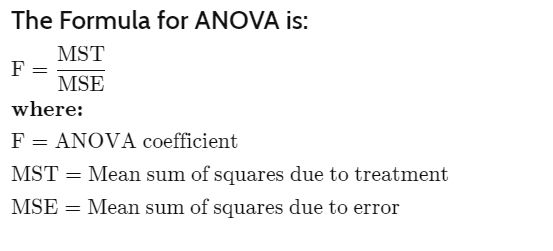Unveiling the Power of ANOVA: Guide to Analyzing Group Variances
Introduction: What is ANOVA?
ANOVA, an acronym for Analysis of Variance, serves as a powerful statistical tool designed to compare the means of three or more groups. The core objective is to ascertain if there’s a significant difference in the means among the groups. By comparing intra-group variance against inter-group variance, Analysis of Variance can help you draw reliable conclusions about how distinct these groups are in terms of the variable you’re scrutinizing.
Table of Contents
Fundamental Assumptions for Applying ANOVA

Anova Formula
Before diving into the application of ANOVA, it’s critical to meet certain assumptions to ensure the reliability of your results:
- Observational Independence: Each observation should be independent of the others.
- Normal Distribution: Either the populations should be normally distributed, or the sample sizes should be large enough to apply the Central Limit Theorem.
- Homogeneity of Variances: The variances across different groups should be roughly equal or homogeneous.
Crafting the Hypothesis: The Foundation of Analysis of Variance
Null Hypothesis (H₀)
The null hypothesis posits that all group means are identical.
Alternative Hypothesis (Hₐ)
The alternative hypothesis suggests that there exists at least one group mean that diverges from the others.
Data Collection: The Backbone of ANOVA
Gather samples for every group you intend to study. The quality and quantity of the collected data can significantly impact the reliability of the ANOVA test.
The Analytical Journey: Performing Analysis of Variance Step-by-Step
- Calculate the Sums of Squares (SS): Compute both within-group and between-group sums of squares.
- Determine the Degrees of Freedom (DF): This involves calculating the degrees of freedom for both within-group and between-group variances.
- Derive the Mean Squares (MS): You’ll obtain the mean squares by dividing the sums of squares by their respective degrees of freedom.
- Compute the F-Statistic:

Assessing the F-Statistic: Critical Value and Decision-Making
Once you’ve calculated the F-statistic, you’ll need to compare it against a critical F-value. This involves choosing an alpha level (commonly 0.05). If your F-statistic exceeds this critical F-value, you reject the null hypothesis.
Post-Hoc Analysis: Further Exploration
If you find yourself rejecting the null hypothesis, you may need additional tests, like Tukey’s HSD, to pinpoint which groups differ significantly from each other.
Analysis of Variance in Action: A Python Example Using scipy.stats
Let’s consider a hypothetical case with three groups (A, B, C):
- Group A: [2, 4, 4, 4, 5, 5, 7, 9]
- Group B: [10, 13, 14, 14, 15, 18, 20, 22]
- Group C: [23, 25, 25, 26, 26, 28, 30, 32]
Here is a Python code snippet to execute a one-way ANOVA:
from scipy import stats
# Data
group_A = [2, 4, 4, 4, 5, 5, 7, 9]
group_B = [10, 13, 14, 14, 15, 18, 20, 22]
group_C = [23, 25, 25, 26, 26, 28, 30, 32]# Execute one-way ANOVA
F, p = stats.f_oneway(group_A, group_B, group_C)# Display results
print(f’F-statistic: {F}’)
print(f’p-value: {p}’)# Make a decision
alpha = 0.05
if p < alpha:
print(‘Null hypothesis rejected. At least one group mean significantly differs.’)
else:
print(‘Null hypothesis retained. No meaningful difference among group means.’)
Wrapping It Up
ANOVA serves as a robust statistical tool for testing the similarity or dissimilarity among the means of three or more groups. Whether you are venturing into complex factorial designs with two-way ANOVAs or exploring longitudinal data with repeated measures ANOVAs, this tool offers a reliable pathway for data analysis.
By adhering to the guidelines outlined in this definitive guide, you can not only grasp the basics but also perform ANOVA with utmost confidence.
1. What is ANOVA?
Analysis of Variance (ANOVA) is a statistical method used to analyze and compare the means of multiple groups to determine if there are any significant differences among the group means.
2. When should I use ANOVA?
ANOVA is used when you have three or more groups and you want to determine if there are significant differences in means between these groups. It’s often used when comparing means from different treatments, groups, or experimental conditions.
3. What are the types of ANOVA?
There are different types of ANOVA based on the number of independent variables and the design of the study. Common types include one-way ANOVA (single factor), two-way ANOVA (two factors), and repeated measures ANOVA (for related groups or repeated measurements).
4. How does ANOVA work?
ANOVA assesses the variability between groups and within groups to determine if the observed differences in means are larger than what you would expect due to random chance. It does this by calculating an F-statistic, which compares the variation between group means to the variation within groups.
5. What is the null hypothesis in ANOVA?
The null hypothesis in ANOVA states that there are no significant differences between the means of the groups being compared. In other words, any observed differences are due to random chance.
6. What is the alternative hypothesis in ANOVA?
The alternative hypothesis in ANOVA states that at least one group mean is significantly different from the others. In other words, there is a significant effect of the independent variable on the dependent variable.
7. How is the F-statistic calculated?
The F-statistic is calculated by dividing the variance between groups by the variance within groups. A larger F-statistic indicates a greater difference between group means relative to the variability within groups.
8. What is the significance level in ANOVA?
The significance level (often denoted as α) is the predetermined threshold for determining whether the differences between group means are statistically significant. Common values for α include 0.05 and 0.01.
9. How do I interpret the results of ANOVA?
If the p-value (probability value) obtained from ANOVA is less than the significance level (α), you can reject the null hypothesis. This suggest that there are significant differences between at least one pair of group means.
Hello, I’m Cansu, a professional dedicated to creating Excel tutorials, specifically catering to the needs of B2B professionals. With a passion for data analysis and a deep understanding of Microsoft Excel, I have built a reputation for providing comprehensive and user-friendly tutorials that empower businesses to harness the full potential of this powerful software.
I have always been fascinated by the intricate world of numbers and the ability of Excel to transform raw data into meaningful insights. Throughout my career, I have honed my data manipulation, visualization, and automation skills, enabling me to streamline complex processes and drive efficiency in various industries.
As a B2B specialist, I recognize the unique challenges that professionals face when managing and analyzing large volumes of data. With this understanding, I create tutorials tailored to businesses’ specific needs, offering practical solutions to enhance productivity, improve decision-making, and optimize workflows.
My tutorials cover various topics, including advanced formulas and functions, data modeling, pivot tables, macros, and data visualization techniques. I strive to explain complex concepts in a clear and accessible manner, ensuring that even those with limited Excel experience can grasp the concepts and apply them effectively in their work.
In addition to my tutorial work, I actively engage with the Excel community through workshops, webinars, and online forums. I believe in the power of knowledge sharing and collaborative learning, and I am committed to helping professionals unlock their full potential by mastering Excel.
With a strong track record of success and a growing community of satisfied learners, I continue to expand my repertoire of Excel tutorials, keeping up with the latest advancements and features in the software. I aim to empower businesses with the skills and tools they need to thrive in today’s data-driven world.
Suppose you are a B2B professional looking to enhance your Excel skills or a business seeking to improve data management practices. In that case, I invite you to join me on this journey of exploration and mastery. Let’s unlock the true potential of Excel together!
https://www.linkedin.com/in/cansuaydinim/










